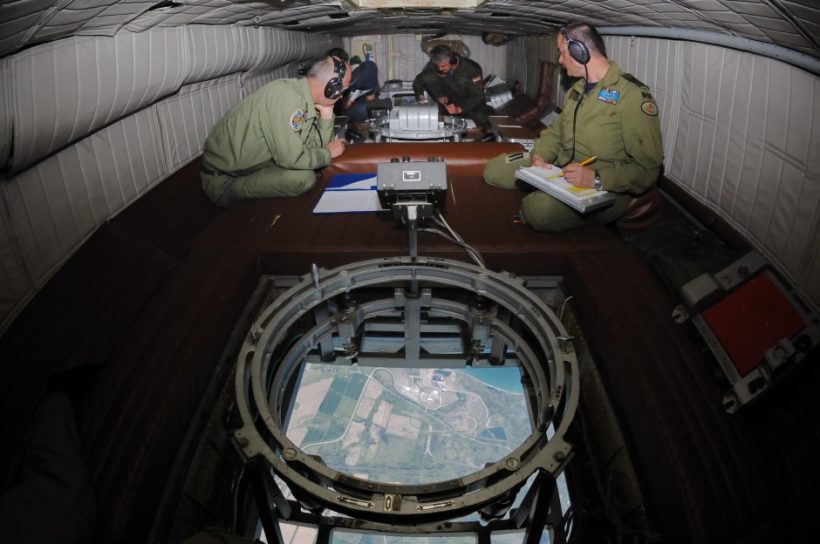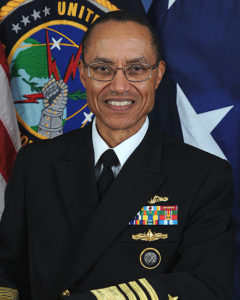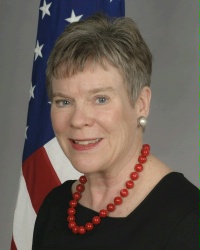
On board a Russian Tu-154M performing an observation flight over Canada, 28 May 2008, under the Open Skies Treaty. (OSCE)
redo Jump to...
print Print...
(from the Associated Press at CBS News) — Russia asked permission on Monday to start flying surveillance planes equipped with high-powered digital cameras amid warnings from U.S. intelligence and military officials that such overflights help Moscow collect intelligence on the United States.
Russia and the United States are signatories to the Open Skies Treaty, which allows unarmed observation flights over the entire territory of all 34 member nations to foster transparency about military activity and help monitor arms control and other agreements. Senior intelligence and military officials, however, worry that Russia is taking advantage of technological advances to violate the spirit of the treaty.
Russia will formally ask the Open Skies Consultative Commission, based in Vienna, to be allowed to fly an aircraft equipped with high-tech sensors over the United States, according to a senior congressional staffer, who spoke on condition of anonymity because the staff member wasn’t authorized to discuss the issue publicly.
The request will put the Obama administration in the position of having to decide whether to let Russia use the high-powered equipment on its surveillance planes at a time when Moscow, according to the latest State Department compliance report, is failing to meet all its obligations under the treaty. And it comes at one of the most tension-filled times in U.S.-Russia relations since the end of the Cold War, with the two countries at odds over Russian activity in Ukraine and Syria.
“The treaty has become a critical component of Russia’s intelligence collection capability directed at the United States,” Adm. Cecil D. Haney, commander of the U.S. Strategic Command, wrote in a letter earlier this year to Rep. Mike Rogers, R-Ala., chairman of a House subcommittee on strategic forces.

Admiral Cecil D. Haney, USN — Commander, U.S. Strategic Command
“In addition to overflying military installations, Russian Open Skies flights can overfly and collect on Department of Defense and national security or national critical infrastructure,” Haney said. “The vulnerability exposed by exploitation of this data and costs of mitigation are increasingly difficult to characterize.”
A State Department official said Sunday that treaty nations had not yet received notice of the Russian request, but that certification of the Russian plane with a “digital electro-optical sensor” could not occur until this summer because the treaty requires a 120-day advance notification. The official spoke on condition of anonymity because he wasn’t authorized to discuss the issue publicly.
The official also said that the treaty, which was entered into force in 2002, establishes procedures for certifying digital sensors to confirm that they are compliant with treaty requirements. The official said all signatories to the treaty agree that “transition from film cameras to digital sensors is required for the long-term viability of the treaty.”
In December, Rose Gottemoeller, Under Secretary of State for Arms Control and International Security, sought to temper concerns about Russian overflights, saying that what Moscow gains from the observation flights is “incremental” to what they collect through other means.

Rose Gottemoeller, Under Secretary of State for Arms Control and International Security for the U.S. State Department.
“One of the advantages of the Open Skies Treaty is that information – imagery – that is taken is shared openly among all the treaty parties,” she said at a joint hearing of the House Foreign Affairs and Armed Services committees in December. “So one of the advantages with the Open Skies Treaty is that we know exactly what the Russians are imaging, because they must share the imagery with us.”
Still, military and intelligence officials have expressed serious concern.
“The open skies construct was designed for a different era,” Lt. Gen. Vincent Stewart, director of the Defense Intelligence Agency [a Department of Defense combat support agency that produce, analyze, and disseminate military intelligence information to combat and non-combat military missions], told lawmakers when asked about the Russian overflights during a congressional hearing. “I’m very concerned about how it’s applied today.”
Robert Work, Deputy Secretary of Defense, told Congress: “We think that they’re going beyond the original intent of the treaty and we continue to look at this very, very closely.”
Steve Rademaker, former assistant secretary of state for the bureau of arms control and the bureau of international security and nonproliferation, told Congress at a hearing on security cooperation in Europe in October that Russia complies with the Open Skies Treaty, but has “adopted a number of measures that are inconsistent with the spirt” of the accord.
The treaty, for instance, obligates each member to make all of its territory available for aerial observation, yet Russia has imposed restrictions on surveillance over Moscow and Chechnya and near Abkhazia and South Ossetia, he said. Russian restrictions also make it hard to conduct observation in the Kaliningrad enclave, said Rademaker, who believes Russia is “selectively implementing” the treaty “in a way that suits its interests.”
From the Associated Press. Reprinted here for educational purposes only. May not be reproduced on other websites without permission from CBSNews. Visit the website at cbsnews .com.
Questions
1. What is Russia asking the Open Skies Consultative Commission permission to do?
2. What is the Open Skies Treaty? (What is its purpose?)
3. What warnings do U.S. intelligence and military officials have about Russia’s request? How does each one explain his concern? Be specific.
4. a) What decision will President Obama have to make regarding Russia’s request?
b) What conflicts do we have with Russia right now?
5. How did the Under Secretary of State for arms control and international security try to downplay concerns over Russia’s flights?
6. What measures has Russia adopted that are “inconsistent with the spirit” of the treaty?
7. Read the “Background” below the questions. Answer the following and ask a parent his/her opinion on each one. Explain your answers:
a) What measures do you think the Obama administration should take in addressing Russia’s potential flights over the U.S. and our military bases?
b) Do you think President Obama should do the same as Turkish President Erdogan and refuse a Russian Open Skies mission over the U.S.?
c) Should this Treaty be reconsidered because of Russia’s actions in Ukraine and Syria? Explain your answer.
d) What position would you want the presidential candidate you support to take on Russia’s application to fly surveillance over the U.S.?
Background
The Treaty on Open Skies
- The Treaty on Open Skies entered into force on January 1, 2002, and currently has 34 States Parties.
- It establishes a program of unarmed aerial surveillance flights over the entire territory of its participants.
- The treaty is designed to enhance mutual understanding and confidence by giving all participants, regardless of size, a direct role in gathering information about military forces and activities of concern to them.
- Open Skies is one of the most wide-ranging international efforts to date promoting openness and transparency of military forces and activities.
- The concept of “mutual aerial observation” was initially proposed to Soviet Premier Nikolai Bulganin at the Geneva Conference of 1955 by President Dwight D. Eisenhower; however, the Soviets promptly rejected the concept and it lay dormant for several years.
- The treaty was eventually signed as an initiative of US president (and former Director of Central Intelligence) George H. W. Bush in 1989. Bush reintroduced the treaty as a means to build confidence and security between all North Atlantic Treaty Organization (NATO) and Warsaw Pact countries.
- Negotiated by the then-members of NATO and the Warsaw Pact, the agreement was signed in Helsinki, Finland, on March 24, 1992. The treaty entered into force on January 2, 2002, after Russia and Belarus completed ratification procedures.
- On Feb. 4, 2016, a Russian Defense Ministry spokesman stated that Turkey had refused Russian Open Skies mission, planned to take place February 1-5, 2016, to fly over the areas adjacent to Syria, as well as over NATO airbases. According to Russia, Turkey gave no explanation to the limitations, and claimed them to indicate illegal military activity in Syrian territory. The OSCC haven’t commented on the alleged violation of the Treaty by the Turkey. (from wikipedia)
The 34 State Parties to the Open Skies Treaty are: Belarus, Belgium, Bosnia and Herzegovina, Bulgaria, Canada, Croatia, Czech Republic,Denmark, Estonia, Finland, France, Georgia, Germany, Greece, Hungary, Iceland, Italy, Latvia, Lithuania, Luxembourg, Netherlands,Norway, Poland, Portugal, Romania, Russian Federation, Slovak Republic, Slovenia, Spain, Sweden, Turkey, Ukraine, United Kingdom, and the United States. Kyrgyzstan has signed but not yet ratified.
Daily “Answers” emails are provided for Daily News Articles, Tuesday’s World Events and Friday’s News Quiz.



